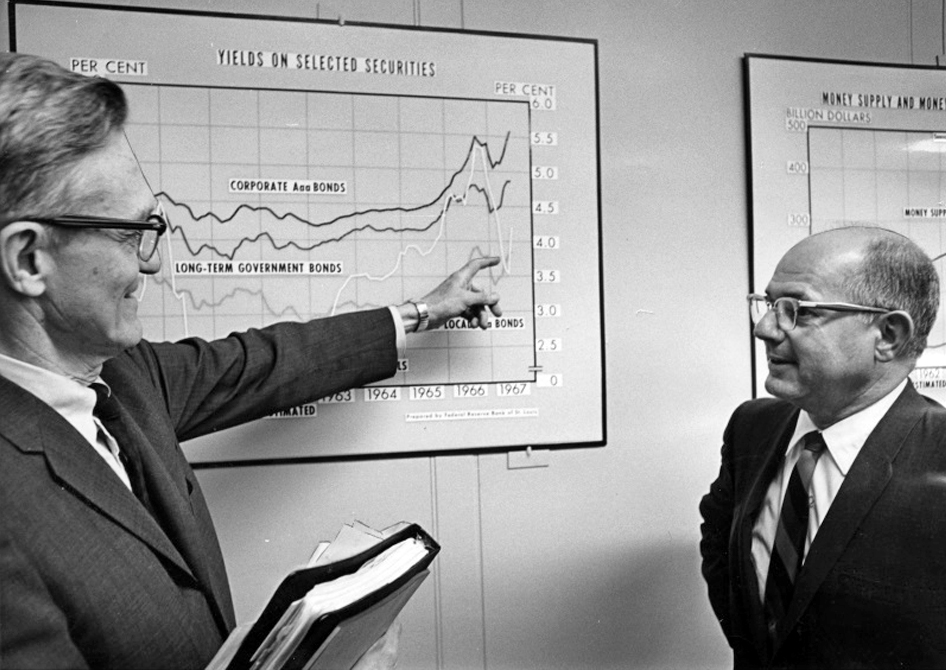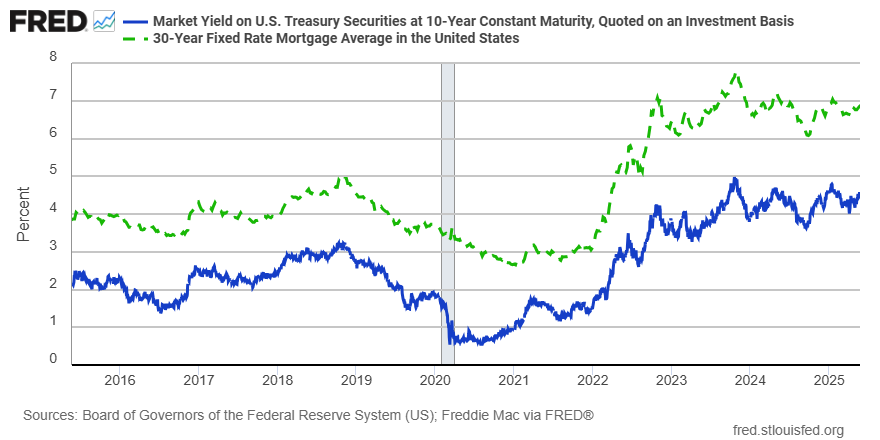Forging Economic Data Partnerships with FRED
On a spring Wednesday in 1961, St. Louis Fed Director of Research Homer Jones sent a brief memo to economists around the United States. Enclosed was a small packet of money supply data. From these humble origins, something remarkable took shape. By the 1970s, what had started with a simple memo had turned into a regular data-sharing publication with tens of thousands of subscribers. In 1991, a dial-up bulletin board known as FRED, for Federal Reserve Economic Data, offered people around the world another way of collecting statistics.
By the mid-1990s, FRED became a web service. This freely accessible resource, supported by the Research Information Services (RIS) team at the St. Louis Fed, now aggregates more than 800,000 data series from more than 100 organizations in the public and private sectors. Improving access to economic data helps people make better informed, data-driven decisions.
Two federal agencies—the Board of Governors of the Federal Reserve System and the U.S. Census Bureau—have in recent years entered into partnerships with the RIS team, aiming to better connect their data with FRED’s user base. This user base initiated more than 35 million website visits and more than 1 billion data requests via FRED’s application programming interface (API) in 2024 alone.

St. Louis Fed Director of Research Homer Jones (left) discusses yields on selected securities with Bank President Darryl Francis on Aug. 30, 1967.
Image via FRASER
Helping People Make Informed, Data-Driven Decisions
The Board of Governors provides data to the public through its Data Download Program (DDP). It is a menu-driven system that creates download files of 19 data releases and allows users to download sections or all of a release. However, the program has only limited data visualization tools.
Since FRED is a market leader in the provision and visualization of economic data, the Board partnered with FRED in 2024 as the tool for widely disseminating DDP data. FRED empowers DDP users with capabilities to combine, transform and visualize Board of Governors data alongside data from other sources.
Additional U.S. public sector sources include:
- Bureau of Economic Analysis
- Bureau of Labor Statistics
- Bureau of Transportation Statistics
- Census Bureau
- Congressional Budget Office
- Department of Housing and Urban Development
- Treasury Department
- Energy Information Administration
- Federal Highway Administration
- Federal Housing Finance Agency
- Office of Management and Budget
- Patent and Trademark Office
The partnership between the RIS team and the Board of Governors has yielded significant improvement of public access to DDP data in several ways, including with:
- A new DDP landing page
- Keyword search and browsing to find DDP and related data
- Graphs and maps that can be tailored by units, frequency and color
- Custom graphs through which users can present Board of Governors data alongside data from dozens of other sources, or make disparate datasets interact with each other
- Personalized dashboards to update and share custom data curations
- Vintage versions, so users can access data from before and after revisions
- API for programmers sourcing data from FRED in specialized output formats
- Microsoft Excel add-in for instant data updates with the click of a button
- Applications for iOS and Android devices
Enhancements to Data Accessibility
In the spirit of further improving access to government information, the RIS team included accessibility enhancement in its Board of Governors partnership work to improve the experience of all FRED users.
Keyboard accessibility
Users now can navigate the structure of FRED pages with keyboards to find content, determine location on graphs and operate interface elements without a mouse.
Screen reader accessibility
FRED graphs have been reformatted to improve the effectiveness of screen reader text-to-speech software, often used by people with sight impairments to access website content.
Color contrast
Colors in FRED graph foregrounds and backgrounds now meet contrast standards that allow users to consume text and nontext elements with greater visual ease. Additionally, color is no longer the sole default differentiator on multiseries line graphs.
Next steps on accessibility work include collection and analysis of survey data from users.

A custom FRED graph of Board of Governors data on the 10-year Treasury yield and Freddie Mac data on 30-year mortgage rates shows improved series line differentiation.
Making Government Data Efficient and Accessible
The RIS team’s reputation among data professionals around the country yields frequent opportunities for additional engagement. In 2019, the Census Bureau and RIS started a partnership after discontinuation of a bureau mobile app. The bureau decided to direct users to the FRED mobile apps instead of investing in the creation of new ones. RIS partnered with the Census Economic Indicators team to ensure full coverage of its datasets in FRED, as well as proper metadata, including series titles, units and notes.
More recently, when the Census Bureau started working on a re-engineered economic survey in 2023, a bureau team reached out to the RIS team for another partnership to distribute the survey data to the public. The Annual Integrated Economic Survey is intended to replace seven annual business surveys and integrate them into a streamlined single survey. It is designed to be easier for businesses to complete, and to result in better and more timely data. The estimated release date for the integrated survey data is later in 2025. Vintage observation sets for the data—in other words, snapshots of a dataset as it was known at particular points in time—will be preserved and made publicly available using ALFRED, also known as archival FRED.

ALFRED, short for archival FRED, is like a time travel service for economic data, preserving datasets as they were known in the past and thus capturing revisions to the datasets in FRED. This graph compares vintages of retail sales data from the Census Bureau.
This latest Census Bureau partnership also focuses on driving data processing efficiencies that will allow for writing more data to FRED faster. Millions of FRED users around the world stand to benefit from technological improvements for prompt, trustworthy delivery and preservation of ever-evolving government data.

St. Louis Fed employees in Research Information Services (RIS) work continuously to ensure FRED remains a world-class resource for curious minds from a wide variety of occupations.
Remaining Focused on the Future
Taken together, the RIS team’s partnerships have established promising precedents for a new level of collaboration between FRED and federal statistical agencies, with efficiency gains remaining top of mind. Further, the preservation capabilities built into FRED, via ALFRED, ensure that data are not only shared rapidly, but also preserved for the public. While decades of work have already gone into giving millions of users around the world much to love about FRED, the RIS team keeps its vision firmly on the future.
This blog explains everyday economics and the Fed, while also spotlighting St. Louis Fed people and programs. Views expressed are not necessarily those of the St. Louis Fed or Federal Reserve System.
Email Us


